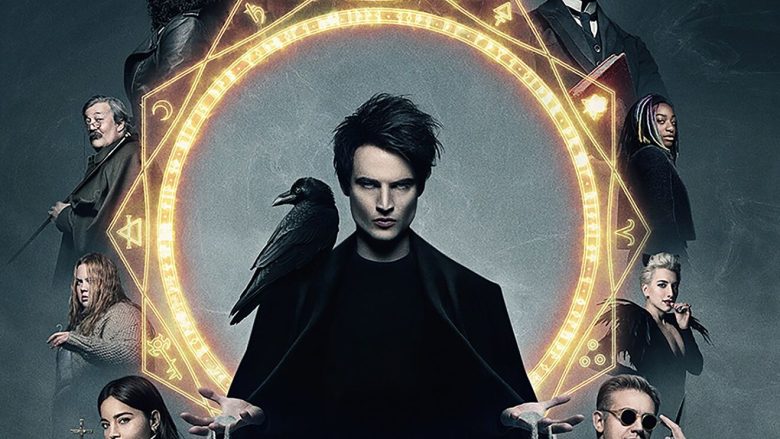Netflix’s The Sandman, an American fantasy drama television series based on the 1989–1996 comic book written by Neil Gaiman and published by DC Comics, accomplishes what for decades had thought to be utterly impossible, bringing Neil Gaiman’s justly legendary comics to life. Gaiman himself, an executive producer on the show, had just about given up hope after a ten -year journey to try and bring them to the screen. The comics ran for 75 issues from 1989 to 1996 and comprised a vast and complicated lore and a huge cast of characters that it was long thought too philosophical, too dark, and too unwieldly to bring to the screen. But Netflix’s ten-episode series (with an additional bonus ep) developed by Gaiman along with David S. Goyer and Allan Heinberg, and executive produced by the three of them and Mike Barker, succeeds beyond yes, most fans’ wildest dreams. Not only does it look stunning, but it does an excellent job of synthesizing the multitude of characters and story lines while not sacrificing the profoundly-layered mythology of the comics.
The main character is Morpheus, Lord of The Dreaming, the realm of humanity’s dreams and nightmares. He is one of The Endless, seven siblings who are anthropomorphic personifications of metaphysical concepts. Along with Morpheus, also known as Dream, there is Death, the twins Desire and Despair, Destiny, Delerium (who used to be known as Delight), and Destruction. Throughout the course of the first season we meet the first four.
The show concentrates on the first two volumes of the comics, Preludes & Nocturnes, and The Doll’s House, which begin with the tale of how Morpheus was captured by a human (Charles Dance, wonderfully menacing as always) who is trying to capture Death in the hopes she will return his beloved son who died in the First World War to him. Instead, he ensnares Morpheus, and refuses to release him until he grants his demands, something The Lord of the Dreaming refuses to do. While Morpheus is held captive for a hundred and five years, the human dream world is severely disrupted. People’s nights are ravaged by nightmares, or they are unable to fall asleep. Some people fall into a deep, coma-like sleep they can never awaken from. Morpheus finally manages to escape only to find that his tools, his sand and helm and ruby, have been stolen and his realm is in ruins. In order to try and restore his dying world, he must first track down and reclaim his tools, the adventures of which form the first half of the season.
The set design is stunning and the visuals perfectly capture the gorgeous, hallucinatory quality of the comic’s artwork. Tom Stoddard is perfection as Morpheus, the brooding god of dreams. He looks remarkably like the character in the books, and uses a deep whispery rasp that sounds like how you would imagine Dream speaking. Furthermore, he ably captures both Dream’s melancholy seductiveness and his sometimes-haughty coldness.
Gaiman’s work was ahead of its time in its use of gay, trans, and diverse characters and the show continues and expands on that. Mason Alexander Park memorably brings the gender-fluid Desire to life and the non-binary actor John Cameron Mitchell gives a heart-felt performance as a drag queen dreaming of Broadway who rents out rooms of his grandmother’s house. Some of the characters who were previously depicted as male have been gender-swapped; the character of Lucienne, who was an older white gentleman named Lucien in the comics is embodied here by Vivienne Acheampong, who, with her shaved hair, large glasses and kind and wise demeanor, makes the role of Morpheus’s faithful librarian and aide de camp her own. Similarly, Gwendolyn Christie is fabulous as Lucifer. Never before has elegant, blonde luminosity seemed so sinister, which reminds us that the ruler of Hell is also known as the Morningstar.
Perhaps the most successful update is to the character of Death. Portrayed as a spiky-haired, white teenager in the comics, she is played, brilliantly, by Kirby Howell-Baptiste, an accomplished British actress who is black. Howell-Baptiste’s performance is a revelation; she gives Death a graceful kindness and inviting warmth which makes her scenes all the more moving. The sixth episode, “The Sound of her Wings,” featuring her is easily the best of the first season.
The cast as a whole is excellent. The show is graced by several stand-out performances, with Boyd Holbrook, all smooth southern charm, fantastic as the nightmarish Corinthian. Patton Oswalt, as Matthew the talking raven, lends a much-appreciated lightness, and his expanded role serves to render Morpheus’ lines, who were often displayed in thought bubbles in the comics, into dialogue instead of lengthy exposition. Kyo Ra gives us a Rose Walker we care deeply about, and Stephen Fry is a joy as Fiddler’s Green. David Thewlis as John Dye manages to be pathetic and horrifying, often in the same scene, as does the amazing Derek Jacobi as Erasmus Fry.
Like the comics themselves, the show takes a meandering, circuitous approach to its story-telling, sometimes seeming to abandon a plot, only to suddenly double-back to pick it up again. Viewers expecting a rising narrative arc may be disappointed with the disjointed story-line, although the last four episodes, which concentrate on Rose Walker’s story, build on each other in a more conventional way than most of the others. Probably the most serious issue with the show as a whole is its pacing: surely, the immortal and highly entertaining life of Hob Gadling (delightfully brought to life by Ferdinand Kingsley) could have merited more than extended flashbacks, while the episode entitled “24/7” seemed to last almost as long. But these are minor quibbles, and hopefully Netflix will see fit to bring us the continuing dreams and nightmares of The Sandman.
- Maureen McCabe







